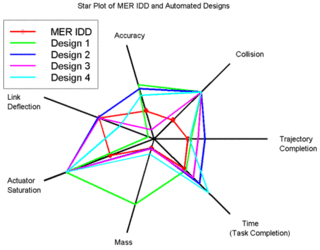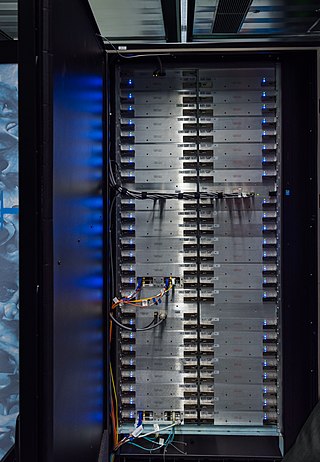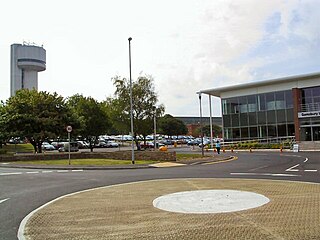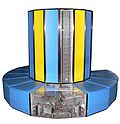
A supercomputer is a type of computer with a high level of performance as compared to a general-purpose computer. The performance of a supercomputer is commonly measured in floating-point operations per second (FLOPS) instead of million instructions per second (MIPS). Since 2017, supercomputers have existed, which can perform over 1017 FLOPS (a hundred quadrillion FLOPS, 100 petaFLOPS or 100 PFLOPS). For comparison, a desktop computer has performance in the range of hundreds of gigaFLOPS (1011) to tens of teraFLOPS (1013). Since November 2017, all of the world's fastest 500 supercomputers run on Linux-based operating systems. Additional research is being conducted in the United States, the European Union, Taiwan, Japan, and China to build faster, more powerful and technologically superior exascale supercomputers.

The Cray-1 was a supercomputer designed, manufactured and marketed by Cray Research. Announced in 1975, the first Cray-1 system was installed at Los Alamos National Laboratory in 1976. Eventually, eighty Cray-1s were sold, making it one of the most successful supercomputers in history. It is perhaps best known for its unique shape, a relatively small C-shaped cabinet with a ring of benches around the outside covering the power supplies and the cooling system.
Cray Inc., a subsidiary of Hewlett Packard Enterprise, is an American supercomputer manufacturer headquartered in Seattle, Washington. It also manufactures systems for data storage and analytics. Several Cray supercomputer systems are listed in the TOP500, which ranks the most powerful supercomputers in the world.
A barrel processor is a CPU that switches between threads of execution on every cycle. This CPU design technique is also known as "interleaved" or "fine-grained" temporal multithreading. Unlike simultaneous multithreading in modern superscalar architectures, it generally does not allow execution of multiple instructions in one cycle.

David A. Bader is a Distinguished Professor and Director of the Institute for Data Science at the New Jersey Institute of Technology. Previously, he served as the Chair of the Georgia Institute of Technology School of Computational Science & Engineering, where he was also a founding professor, and the executive director of High-Performance Computing at the Georgia Tech College of Computing. In 2007, he was named the first director of the Sony Toshiba IBM Center of Competence for the Cell Processor at Georgia Tech.
The Pittsburgh Supercomputing Center (PSC) is a high performance computing and networking center founded in 1986 and one of the original five NSF Supercomputing Centers. PSC is a joint effort of Carnegie Mellon University and the University of Pittsburgh in Pittsburgh, Pennsylvania, United States.

The National Energy Research Scientific Computing Center (NERSC), is a high-performance computing (supercomputer) National User Facility operated by Lawrence Berkeley National Laboratory for the United States Department of Energy Office of Science. As the mission computing center for the Office of Science, NERSC houses high performance computing and data systems used by 9,000 scientists at national laboratories and universities around the country. Research at NERSC is focused on fundamental and applied research in energy efficiency, storage, and generation; Earth systems science, and understanding of fundamental forces of nature and the universe. The largest research areas are in High Energy Physics, Materials Science, Chemical Sciences, Climate and Environmental Sciences, Nuclear Physics, and Fusion Energy research. NERSC's newest and largest supercomputer is Perlmutter, which debuted in 2021 ranked 5th on the TOP500 list of world's fastest supercomputers.

Cray XMT is a scalable multithreaded shared memory supercomputer architecture by Cray, based on the third generation of the Tera MTA architecture, targeted at large graph problems. Presented in 2005, it supersedes the earlier unsuccessful Cray MTA-2. It uses the Threadstorm3 CPUs inside Cray XT3 blades. Designed to make use of commodity parts and existing subsystems for other commercial systems, it alleviated the shortcomings of Cray MTA-2's high cost of fully custom manufacture and support. It brought various substantial improvements over Cray MTA-2, most notably nearly tripling the peak performance, and vastly increased maximum CPU count to 8,192 and maximum memory to 128 TB, with a data TLB of maximal 512 TB.

A radar chart is a graphical method of displaying multivariate data in the form of a two-dimensional chart of three or more quantitative variables represented on axes starting from the same point. The relative position and angle of the axes is typically uninformative, but various heuristics, such as algorithms that plot data as the maximal total area, can be applied to sort the variables (axes) into relative positions that reveal distinct correlations, trade-offs, and a multitude of other comparative measures.
Aster Data Systems was a data management and analysis software company headquartered in San Carlos, California. It was founded in 2005 and acquired by Teradata in 2011.
Cultural analytics refers to the use of computational, visualization, and big data methods for the exploration of contemporary and historical cultures. While digital humanities research has focused on text data, cultural analytics has a particular focus on massive cultural data sets of visual material – both digitized visual artifacts and contemporary visual and interactive media. Taking on the challenge of how to best explore large collections of rich cultural content, cultural analytics researchers developed new methods and intuitive visual techniques that rely on high-resolution visualization and digital image processing. These methods are used to address both the existing research questions in humanities, to explore new questions, and to develop new theoretical concepts that fit the mega-scale of digital culture in the early 21st century.

IBM Watson is a computer system capable of answering questions posed in natural language. It was developed as a part of IBM's DeepQA project by a research team, led by principal investigator David Ferrucci. Watson was named after IBM's founder and first CEO, industrialist Thomas J. Watson.

Big data primarily refers to data sets that are too large or complex to be dealt with by traditional data-processing application software. Data with many entries (rows) offer greater statistical power, while data with higher complexity may lead to a higher false discovery rate. Though used sometimes loosely partly due to a lack of formal definition, the best interpretation is that it is a large body of information that cannot be comprehended when used in small amounts only.
The Graph500 is a rating of supercomputer systems, focused on data-intensive loads. The project was announced on International Supercomputing Conference in June 2010. The first list was published at the ACM/IEEE Supercomputing Conference in November 2010. New versions of the list are published twice a year. The main performance metric used to rank the supercomputers is GTEPS.

SAP HANA is an in-memory, column-oriented, relational database management system developed and marketed by SAP SE. Its primary function as the software running a database server is to store and retrieve data as requested by the applications. In addition, it performs advanced analytics and includes extract, transform, load (ETL) capabilities as well as an application server.

The Cray XC40 is a massively parallel multiprocessor supercomputer manufactured by Cray. It consists of Intel Haswell Xeon processors, with optional Nvidia Tesla or Intel Xeon Phi accelerators, connected together by Cray's proprietary "Aries" interconnect, stored in air-cooled or liquid-cooled cabinets. The XC series supercomputers are available with the Cray DataWarp applications I/O accelerator technology.

The Hartree Centre is a high performance computing, data analytics and artificial intelligence (AI) research facility focused on industry-led challenges. It was formed in 2012 at Daresbury Laboratory on the Sci-Tech Daresbury science and innovation campus in Cheshire, UK. The Hartree Centre is part of the Science and Technology Facilities Council (STFC) which itself is part of United Kingdom Research and Innovation (UKRI).
The Cray Urika-XA extreme analytics platform, manufactured by supercomputer maker Cray Inc., was an appliance that analyzes the massive amounts of data—usually called big data—that supercomputers collect. It was introduced in 2015 and discontinued in 2017. Organizations that use supercomputers have traditionally used multiple smaller off-the-shelf systems for data analysis. But as organizations see a dramatic increase in the amount of data they collect—everything from research data to retail transactions—they need data analytics systems that can make sense of it and help them use it strategically. In a nod to organizations that lean toward open-source software, the Urika-XA comes pre-installed with Cloudera Enterprise Hadoop and Apache Spark.
Sports analytics are collections of relevant historical statistics that can provide a competitive advantage to a team or individual. Through the collection and analysis of these data, sports analytics inform players, coaches and other staff in order to facilitate decision making both during and prior to sporting events. The term "sports analytics" was popularized in mainstream sports culture following the release of the 2011 film, Moneyball, in which Oakland Athletics General Manager Billy Beane relies heavily on the use of baseball analytics, building upon and extending the established practice of Sabermetrics, to build a competitive team on a minimal budget.

Merative L.P., formerly IBM Watson Health, is an American medical technology company that provides products and services that help clients facilitate medical research, clinical research, real world evidence, and healthcare services, through the use of artificial intelligence, data analytics, cloud computing, and other advanced information technology. Merative is owned by Francisco Partners, an American private equity firm headquartered in San Francisco, California. In 2022, IBM divested and spun-off their Watson Health division into Merative. As of 2023, it remains a standalone company headquartered in Ann Arbor with innovation centers in Hyderabad, Bengaluru, and Chennai.












